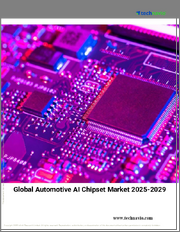
|
시장보고서
상품코드
1776735
세계의 AI 칩 시장 : 예측 - 칩 유형별, 처리 유형별, 기능별, 테크놀로지 노드별, 메모리 유형별, 용도별, 최종 사용자별, 지역별 분석(-2032년)AI Chips Market Forecasts to 2032 - Global Analysis by Chip Type (Central Processing Unit, Graphics Processing Unit and Other Chip Types), Processing Type, Functionality, Technology Node, Memory Type, Application, End User and By Geography |
||||||
Stratistics MRC에 따르면 세계의 AI 칩 시장은 2025년에 1,703억 달러로 추정되고, 예측 기간 동안 CAGR은 22.9%로 성장할 전망이며, 2032년에는 7,215억 달러에 이를 것으로 예측됩니다.
AI 칩은 머신러닝이나 딥러닝 등의 인공지능 태스크를 처리하기 위해 설계된 전용 프로세서입니다. 이 칩은 대량의 데이터를 병렬 처리함으로써 복잡한 계산을 고속화합니다. 보다 고속으로 효율적인 AI 모델에 대한 수요가 높아지는 가운데, 이러한 칩은 헬스케어나 금융으로부터 로봇 공학이나 스마트 디바이스에 이르기까지, 업계 전체에서 불가결한 것이 되고 있습니다.
엔비디아에 따르면 AI 워크로드를 지원하는 GPU 컴퓨팅 수요가 급증하고 있으며, 데이터센터 매출은 2024년도 2분기에 226억 달러(전년 동기 대비 171% 증가)에 달했습니다.
업계를 가로지르는 AI 도입의 폭발적 성장
헬스케어, 자동차, 금융, 제조 등의 분야에서 인공지능이 급속히 통합되고 있는 것이 AI 칩 시장의 주요 촉진요인이 되고 있습니다. 자동화, 분석, 의사결정에 AI를 활용하는 기업이 늘면서 복잡한 계산을 처리할 수 있는 전용 칩 수요가 급증하고 있습니다. 이러한 광범위한 채용은 대기업에만 국한된 것이 아니며, 중소기업도 AI 주도의 솔루션을 도입하고 있습니다. 또한 데이터센터 및 클라우드 기반 서비스의 보급으로 고성능 AI 칩의 수요가 높아지고 있어 시장 확대에 박차를 가하고 있습니다.
높은 연구개발 및 제조 비용
첨단 AI 칩의 개발과 제조는 연구 개발, 전문 인력, 최첨단 제조 설비에 많은 투자를 필요로 하는 고가의 복잡한 프로세스입니다. 칩 설계의 복잡성은 진화하는 AI 알고리즘에 대응하기 위한 끊임없는 기술 혁신의 필요성과 맞물려 높은 진입 장벽을 만들어내고 있습니다. 게다가 공급망의 혼란이나 중요한 원재료의 부족은 비용을 더욱 상승시킬 가능성이 있습니다. 이러한 요인은 특히 신규 참가 기업 및 소규모 기업에 있어서, 총체적으로 시장의 성장을 제약해 업계의 기술 진보의 페이스를 늦출 가능성이 있습니다.
AI 알고리즘 및 모델 진보
AI 알고리즘과 모델의 지속적인 획기적인 변화는 큰 기회를 제공합니다. 모델이 보다 세련되고 리소스를 대량으로 소비하게 됨에 따라 이러한 워크로드를 효율적으로 처리할 수 있는 하드웨어의 필요성이 높아지고 있습니다. 게다가 에지 컴퓨팅의 진화와 로봇 공학, IoT, 자율 시스템에서 새로운 AI 애플리케이션의 출현이 혁신적인 칩 아키텍처 수요를 촉진하고 있습니다. 업계가 성능과 에너지 효율에 모두 최적화된 하드웨어를 요구하는 가운데, 이러한 진보를 잘 이용하는 기업은 채용 확대에 따른 이익을 누리게 됩니다.
윤리적 우려 및 규제 모니터링
AI 칩은 윤리적 배려와 규제 감독에 의한 과제가 산적하고 있습니다. 데이터 프라이버시, 알고리즘 편향, AI 기술 악용 가능성과 같은 문제는 정부와 규제기관에 보다 엄격한 가이드라인 도입을 촉구하고 있습니다. 이러한 규제의 진전은 컴플라이언스 비용을 증대시켜 제품의 출시를 늦출 가능성이 있습니다. 게다가 세간의 감시의 눈이 엄격해지면서 소비자 신뢰에 영향을 미쳐 AI를 활용한 솔루션 채택이 지연될 가능성도 있습니다.
COVID-19의 영향 :
COVID-19의 대유행은 당초 세계 공급망과 제조업무를 혼란시켜 AI 칩의 생산과 전개에 지연을 가져왔습니다. 하지만 이 위기는 조직이 원격근무로 전환되고 AI 구동형 기술에 대한 의존도가 높아짐에 따라 디지털 전환을 가속화하기도 했습니다. 이 때문에 헬스케어, 물류, 전자상거래 등 분야에서 AI 칩 수요가 급증했습니다. 초기 좌절에도 불구하고 시장은 빠르게 적응했고, AI 인프라에 대한 투자가 증가했으며, 업계는 팬데믹 이후 견조한 성장을 위해 자리매김했습니다.
예측 기간 동안 그래픽 프로세싱 유닛(GPU) 분야가 최대가 될 전망
그래픽 프로세싱 유닛(GPU) 부문은 예측 기간 동안 가장 큰 시장 점유율을 차지할 것으로 예측됩니다. GPU는 병렬 처리 능력을 통해 데이터센터, 클라우드 환경, 고성능 컴퓨팅 애플리케이션에서 복잡한 AI 워크로드를 처리하는 데 가장 적합하다고 지지받고 있습니다. 엔비디아, AMD, 인텔 등 대기업들은 지속적인 기술 혁신과 딥러닝, 자연어 처리, 컴퓨터 비전 등 AI를 활용하는 업계의 왕성한 수요로 이 분야에서 확고한 입지를 구축하고 있습니다. 제네레이티브 AI 및 대규모 언어 모델이 보급됨에 따라 이 우위성은 지속될 것으로 보입니다.
예측 기간 동안 가장자리 부문의 CAGR이 가장 높을 것으로 예상
예측 기간 동안 가장자리 부문이 가장 높은 성장률을 보일 것으로 예측됩니다. 자율주행차, 스마트 디바이스, 산업 자동화에 있어서 실시간 데이터 처리 및 저레이턴시 AI 애플리케이션의 요구 고조가, 엣지 AI 칩의 수요를 촉진하고 있습니다. 이러한 칩은 로컬 처리를 가능하게 하고 클라우드 인프라에 대한 의존도를 줄이며 속도, 프라이버시, 에너지 효율을 향상시킵니다. IoT 채택이 확대되고 온디바이스 인텔리전스를 필요로 하는 디바이스가 늘어남에 따라 엣지 부문은 대폭 가속될 것으로 보입니다.
최대 점유율을 차지하는 지역
예측 기간 동안 북미가 가장 큰 시장 점유율을 차지할 것으로 예측됩니다. 이 우위성은, 주요 테크놀로지 기업의 존재, 강고한 이노베이션 에코 시스템, AI 연구 개발에 대한 고액의 투자에 기인합니다. 이 지역에서는 헬스케어부터 자동차에 이르는 다양한 분야에서 AI 기술이 조기에 채택되고 있어 수요를 더욱 뒷받침하고 있습니다. 아울러 정부의 지원책과 벤처캐피털의 자금조달로 AI칩 혁신과 상업화에 유리한 환경이 조성돼 북미 리더십이 확고해지고 있습니다.
CAGR이 가장 높은 지역 :
예측 기간 동안 아시아태평양이 가장 높은 CAGR을 나타낼 것으로 예측됩니다. 급속한 디지털화, 산업 자동화 확대, AI 인프라 투자 증가가 이 지역의 주요 촉진 요인입니다. 중국, 일본, 한국과 같은 국가들은 정부의 강력한 정책과 하이테크 신흥 기업의 성장 생태계에 힘입어 AI 칩 제조와 전개의 최전선에 있습니다. 스마트 디바이스 및 IoT 애플리케이션의 보급은 저렴한 가격의 AI 솔루션에 대한 수요 증가와 맞물려 아시아태평양 지역을 가장 급성장하고 있는 지역으로 자리매김하고 있습니다.
사용자 정의 무료 제공 :
이 보고서를 구독하는 고객에게는 다음 무료 맞춤설정 옵션 중 하나를 제공합니다.
- 기업 프로파일
- 추가 시장 기업의 종합적 프로파일링(3개사까지)
- 주요 기업의 SWOT 분석(3개사까지)
- 지역 세분화
- 고객의 관심에 응한 주요국 시장 추계, 예측 및 CAGR(주 : 타당성 확인에 따름)
- 경쟁 벤치마킹
- 제품 포트폴리오, 지리적 존재, 전략적 제휴에 기반한 주요 기업 벤치마킹
목차
제1장 주요 요약
제2장 서문
- 개요
- 이해관계자
- 조사 범위
- 조사 방법
- 데이터 마이닝
- 데이터 분석
- 데이터 검증
- 조사 접근
- 조사 자료
- 1차 조사 자료
- 2차 조사 정보원
- 전제조건
제3장 시장 동향 분석
- 성장 촉진요인
- 성장 억제요인
- 기회
- 위협
- 기술 분석
- 용도 분석
- 최종 사용자 분석
- 신흥 시장
- COVID-19의 영향
제4장 Porter's Five Forces 분석
- 공급기업의 협상력
- 구매자의 협상력
- 대체품의 위협
- 신규 참가업체의 위협
- 경쟁 기업간 경쟁 관계
제5장 세계의 AI칩 시장 : 칩 유형별
- 중앙처리장치(CPU)
- 그래픽 프로세싱 유닛(GPU)
- 필드 프로그래머블 게이트 어레이(FPGA)
- 특정 용도용 집적 회로(ASIC)
- 뉴럴 프로세싱 유닛(NPU)
- 텐서 프로세싱 유닛(TPU)
- 기타 커스텀 AI 가속기
- 기타 칩 유형
제6장 세계의 AI 칩 시장 : 처리 유형별
- 엣지
- 클라우드
- 온프레미스
제7장 세계의 AI 칩 시장 : 기능별
- 트레이닝
- 추론
제8장 세계의 AI 칩 시장 : 기술 노드별
- 10nm 이하
- 10nm-20nm
- 20nm 이상
제9장 세계의 AI 칩 시장 : 메모리 유형별
- DDR(DRAM)
- HBM(고대역폭 메모리)
- 기타 메모리 유형
제10장 세계의 AI 칩 시장 : 용도별
- 자연언어처리(NLP)
- 컴퓨터 비전
- 생성형 AI
- 네트워크 보안
- 로봇 공학
- 예측 분석
- 기타 용도
제11장 세계의 AI 칩 시장 : 최종 사용자별
- 가전
- 데이터센터
- 자동차
- 헬스케어
- BFSI
- IT 및 통신
- 산업
- 항공우주 및 방위
- 소매
- 농업
- 기타 최종 사용자
제12장 세계의 AI 칩 시장 : 지역별
- 북미
- 미국
- 캐나다
- 멕시코
- 유럽
- 독일
- 영국
- 이탈리아
- 프랑스
- 스페인
- 기타 유럽
- 아시아태평양
- 일본
- 중국
- 인도
- 호주
- 뉴질랜드
- 한국
- 기타 아시아태평양
- 남미
- 아르헨티나
- 브라질
- 칠레
- 기타 남미
- 중동 및 아프리카
- 사우디아라비아
- 아랍에미리트(UAE)
- 카타르
- 남아프리카
- 기타 중동 및 아프리카
제13장 주요 발전
- 계약, 파트너십, 협업 및 합작투자
- 인수 및 합병
- 신제품 발매
- 사업 확대
- 기타 주요 전략
제14장 기업 프로파일링
- NVIDIA Corporation
- Intel Corporation
- Advanced Micro Devices, Inc.(AMD)
- Qualcomm Technologies, Inc.
- Alphabet Inc.(Google LLC)
- IBM Corporation
- Samsung Electronics Co., Ltd.
- Huawei Technologies Co., Ltd.
- Baidu, Inc.
- Apple Inc.
- Microsoft Corporation
- Amazon Web Services, Inc.
- Broadcom Inc.
- MediaTek Inc.
- Graphcore Limited
- Rebellions Inc.
- SK Hynix Inc.
- Sapeon Inc.
According to Stratistics MRC, the Global AI Chips Market is accounted for $170.3 billion in 2025 and is expected to reach $721.5 billion by 2032 growing at a CAGR of 22.9% during the forecast period. AI chips are specialized processors designed to handle artificial intelligence tasks like machine learning and deep learning. These chips accelerate complex computations by processing large volumes of data in parallel. With growing demand for faster, more efficient AI models, these chips are becoming essential across industries, from healthcare and finance to robotics and smart devices.
According to NVIDIA, the demand for GPU computing to support AI workloads has surged, with data center revenue reaching $22.6 billion in Q2 FY2024, a 171% increase year-over-year.
Market Dynamics:
Driver:
Explosive growth of Ai adoption across industries
The rapid integration of artificial intelligence across sectors such as healthcare, automotive, finance, and manufacturing is a primary driver for the AI chips market. As organizations increasingly leverage AI for automation, analytics, and decision-making, the demand for specialized chips capable of handling complex computations has surged. This widespread adoption is not limited to large enterprises; small and medium-sized businesses are also embracing AI-driven solutions. Furthermore, the proliferation of data centers and cloud-based services has intensified the need for high-performance AI chips, fueling market expansion.
Restraint:
High research & development and manufacturing costs
Developing and manufacturing advanced AI chips is an expensive and intricate process, requiring significant investments in R&D, specialized talent, and state-of-the-art fabrication facilities. The complexity of chip design, coupled with the need for constant innovation to keep pace with evolving AI algorithms, creates high entry barriers. Additionally, supply chain disruptions and the scarcity of critical raw materials can further escalate costs. These factors collectively constrain market growth, particularly for new entrants and smaller firms, and may slow the pace of technological advancement in the industry.
Opportunity:
Advancements in Ai algorithms and models
Ongoing breakthroughs in AI algorithms and models present substantial opportunities. As models become more sophisticated and resource-intensive, there is a growing need for hardware that can efficiently process these workloads. Moreover, the evolution of edge computing and the emergence of new AI applications in robotics, IoT, and autonomous systems are driving demand for innovative chip architectures. Companies that successfully harness these advancements stand to benefit from increased adoption, as industries seek hardware optimized for both performance and energy efficiency.
Threat:
Ethical concerns and regulatory scrutiny
AI chips face mounting challenges from ethical considerations and regulatory oversight. Issues such as data privacy, algorithmic bias, and the potential misuse of AI technologies have prompted governments and regulatory bodies to introduce stricter guidelines. These evolving regulations can increase compliance costs and delay product launches. Additionally, heightened public scrutiny may impact consumer trust and slow the adoption of AI-powered solutions.
Covid-19 Impact:
The Covid-19 pandemic initially disrupted global supply chains and manufacturing operations, causing delays in AI chip production and deployment. However, the crisis also accelerated digital transformation as organizations shifted to remote work and increased reliance on AI-driven technologies. This led to a surge in demand for AI chips in sectors such as healthcare, logistics, and e-commerce. Despite early setbacks, the market quickly adapted, and investments in AI infrastructure rose, positioning the industry for robust post-pandemic growth.
The graphics processing unit (GPU) segment is expected to be the largest during the forecast period
The graphics processing unit (GPU) segment is expected to account for the largest market share during the forecast period. GPUs are favored for their parallel processing capabilities, making them ideal for handling complex AI workloads in data centers, cloud environments, and high-performance computing applications. Major players such as NVIDIA, AMD, and Intel have established strong positions in this segment, driven by continuous innovation and robust demand from industries leveraging AI for deep learning, natural language processing, and computer vision. This dominance is set to persist as generative AI and large language models become more prevalent.
The edge segment is expected to have the highest CAGR during the forecast period
Over the forecast period, the edge segment is predicted to witness the highest growth rate. The increasing need for real-time data processing and low-latency AI applications in autonomous vehicles, smart devices, and industrial automation is propelling demand for edge AI chips. These chips enable local processing, reducing reliance on cloud infrastructure and improving speed, privacy, and energy efficiency. As IoT adoption expands and more devices require on-device intelligence, the edge segment will experience significant acceleration.
Region with largest share:
During the forecast period, the North America region is expected to hold the largest market share. This dominance is attributed to the presence of leading technology companies, robust innovation ecosystems, and substantial investments in AI research and development. The region's early adoption of AI technologies across diverse sectors ranging from healthcare to automotive further bolsters demand. Additionally, supportive government initiatives and venture capital funding have fostered a favorable environment for AI chip innovation and commercialization, solidifying North America's leadership.
Region with highest CAGR:
Over the forecast period, the Asia Pacific region is anticipated to exhibit the highest CAGR. Rapid digitalization, expanding industrial automation, and increasing investments in AI infrastructure are key drivers in this region. Countries like China, Japan, and South Korea are at the forefront of AI chip manufacturing and deployment, supported by strong government policies and a growing ecosystem of tech startups. The proliferation of smart devices and IoT applications, coupled with rising demand for affordable AI solutions, positions Asia Pacific as the fastest-growing region.
Key players in the market
Some of the key players in AI Chips Market include NVIDIA Corporation, Intel Corporation, Advanced Micro Devices, Inc. (AMD), Qualcomm Technologies, Inc., Alphabet Inc. (Google LLC), IBM Corporation, Samsung Electronics Co., Ltd., Huawei Technologies Co., Ltd., Baidu, Inc., Apple Inc., Microsoft Corporation, Amazon Web Services, Inc., Broadcom Inc., MediaTek Inc., Graphcore Limited, Rebellions Inc., SK Hynix Inc. and Sapeon Inc.
Key Developments:
In June 2025, AMD launched the AMD Instinct(TM) MI350 Series, delivering up to 4 x generation-on-generations AI compute improvement and up to 35x leap in inferencing performance. AMD also showcased its new developer cloud to empowering AI developers with seamless access to AMD Instinct GPUs and ROCm for their AI innovation. The company also previewed its next-gen "Helios" AI rack infrastructure, integrating MI400 GPUs, EPYC "Venice" CPUs, and Pensando "Vulcano" NICs for unprecedented AI compute density and scalability
In May 2025, NVIDIA announced that Taiwan's leading system manufacturers are set to build NVIDIA DGX Spark and DGX Station(TM) systems. Growing partnerships with Acer, GIGABYTE and MSI will extend the availability of DGX Spark and DGX Station personal AI supercomputers - empowering a global ecosystem of developers, data scientists and researchers with unprecedented performance and efficiency. Enterprises, software providers, government agencies, startups and research institutions need robust systems that can deliver the performance and capabilities of an AI server in a desktop form factor without compromising data size, proprietary model privacy or the speed of scalability.
In May 2025, At Embedded World Germany, Qualcomm Technologies, Inc. announced the entry into an agreement to acquire EdgeImpulse Inc., which will enhance its offering for developers and expand its leadership in AI capabilities to power AI-enabled products and services across IoT. The closing of this deal is subject to customary closing conditions. This acquisition is anticipated to complement Qualcomm Technologies' strategic approach to IoT transformation, which includes a comprehensive chipset roadmap, unified software architecture, a suite of services, developer resources, ecosystem partners, comprehensive solutions, and IoT blueprints to address diverse industry needs and challenges.
Chip Types Covered:
- Central Processing Unit (CPU)
- Graphics Processing Unit (GPU)
- Field Programmable Gate Array (FPGA)
- Application-Specific Integrated Circuit (ASIC)
- Other Chip Types
Processing Types:
- Edge
- Cloud
- On-premise
Functionalities Covered:
- Training
- Inference
Technology Nodes Covered:
- 10nm and Below
- 10nm to 20nm
- 20nm and Above
Memory Types Covered:
- DDR (DRAM)
- HBM (High-Bandwidth Memory)
- Other Memory Types
Applications Covered:
- Natural Language Processing (NLP)
- Computer Vision
- Generative AI
- Network Security
- Robotics
- Predictive Analysis
- Other Applications
End Users Covered:
- Consumer Electronics
- Data Centers
- Automotive
- Healthcare
- BFSI
- IT & Telecom
- Industrial
- Aerospace & Defense
- Retail
- Agriculture
- Other End Users
Regions Covered:
- North America
- US
- Canada
- Mexico
- Europe
- Germany
- UK
- Italy
- France
- Spain
- Rest of Europe
- Asia Pacific
- Japan
- China
- India
- Australia
- New Zealand
- South Korea
- Rest of Asia Pacific
- South America
- Argentina
- Brazil
- Chile
- Rest of South America
- Middle East & Africa
- Saudi Arabia
- UAE
- Qatar
- South Africa
- Rest of Middle East & Africa
What our report offers:
- Market share assessments for the regional and country-level segments
- Strategic recommendations for the new entrants
- Covers Market data for the years 2024, 2025, 2026, 2028, and 2032
- Market Trends (Drivers, Constraints, Opportunities, Threats, Challenges, Investment Opportunities, and recommendations)
- Strategic recommendations in key business segments based on the market estimations
- Competitive landscaping mapping the key common trends
- Company profiling with detailed strategies, financials, and recent developments
- Supply chain trends mapping the latest technological advancements
Free Customization Offerings:
All the customers of this report will be entitled to receive one of the following free customization options:
- Company Profiling
- Comprehensive profiling of additional market players (up to 3)
- SWOT Analysis of key players (up to 3)
- Regional Segmentation
- Market estimations, Forecasts and CAGR of any prominent country as per the client's interest (Note: Depends on feasibility check)
- Competitive Benchmarking
- Benchmarking of key players based on product portfolio, geographical presence, and strategic alliances
Table of Contents
1 Executive Summary
2 Preface
- 2.1 Abstract
- 2.2 Stake Holders
- 2.3 Research Scope
- 2.4 Research Methodology
- 2.4.1 Data Mining
- 2.4.2 Data Analysis
- 2.4.3 Data Validation
- 2.4.4 Research Approach
- 2.5 Research Sources
- 2.5.1 Primary Research Sources
- 2.5.2 Secondary Research Sources
- 2.5.3 Assumptions
3 Market Trend Analysis
- 3.1 Introduction
- 3.2 Drivers
- 3.3 Restraints
- 3.4 Opportunities
- 3.5 Threats
- 3.6 Technology Analysis
- 3.7 Application Analysis
- 3.8 End User Analysis
- 3.9 Emerging Markets
- 3.10 Impact of Covid-19
4 Porters Five Force Analysis
- 4.1 Bargaining power of suppliers
- 4.2 Bargaining power of buyers
- 4.3 Threat of substitutes
- 4.4 Threat of new entrants
- 4.5 Competitive rivalry
5 Global AI Chips Market, By Chip Type
- 5.1 Introduction
- 5.2 Central Processing Unit (CPU)
- 5.3 Graphics Processing Unit (GPU)
- 5.4 Field Programmable Gate Array (FPGA)
- 5.5 Application-Specific Integrated Circuit (ASIC)
- 5.5.1 Neural Processing Units (NPUs)
- 5.5.2 Tensor Processing Units (TPUs)
- 5.5.3 Other Custom AI Accelerators
- 5.6 Other Chip Types
6 Global AI Chips Market, By Processing Type
- 6.1 Introduction
- 6.2 Edge
- 6.3 Cloud
- 6.4 On-premise
7 Global AI Chips Market, By Functionality
- 7.1 Introduction
- 7.2 Training
- 7.3 Inference
8 Global AI Chips Market, By Technology Node
- 8.1 Introduction
- 8.2 10nm and Below
- 8.3 10nm to 20nm
- 8.4 20nm and Above
9 Global AI Chips Market, By Memory Type
- 9.1 Introduction
- 9.2 DDR (DRAM)
- 9.3 HBM (High-Bandwidth Memory)
- 9.4 Other Memory Types
10 Global AI Chips Market, By Application
- 10.1 Introduction
- 10.2 Natural Language Processing (NLP)
- 10.3 Computer Vision
- 10.4 Generative AI
- 10.5 Network Security
- 10.6 Robotics
- 10.7 Predictive Analysis
- 10.8 Other Applications
11 Global AI Chips Market, By End User
- 11.1 Introduction
- 11.2 Consumer Electronics
- 11.3 Data Centers
- 11.4 Automotive
- 11.5 Healthcare
- 11.6 BFSI
- 11.7 IT & Telecom
- 11.8 Industrial
- 11.9 Aerospace & Defense
- 11.10 Retail
- 11.11 Agriculture
- 11.12 Other End Users
12 Global AI Chips Market, By Geography
- 12.1 Introduction
- 12.2 North America
- 12.2.1 US
- 12.2.2 Canada
- 12.2.3 Mexico
- 12.3 Europe
- 12.3.1 Germany
- 12.3.2 UK
- 12.3.3 Italy
- 12.3.4 France
- 12.3.5 Spain
- 12.3.6 Rest of Europe
- 12.4 Asia Pacific
- 12.4.1 Japan
- 12.4.2 China
- 12.4.3 India
- 12.4.4 Australia
- 12.4.5 New Zealand
- 12.4.6 South Korea
- 12.4.7 Rest of Asia Pacific
- 12.5 South America
- 12.5.1 Argentina
- 12.5.2 Brazil
- 12.5.3 Chile
- 12.5.4 Rest of South America
- 12.6 Middle East & Africa
- 12.6.1 Saudi Arabia
- 12.6.2 UAE
- 12.6.3 Qatar
- 12.6.4 South Africa
- 12.6.5 Rest of Middle East & Africa
13 Key Developments
- 13.1 Agreements, Partnerships, Collaborations and Joint Ventures
- 13.2 Acquisitions & Mergers
- 13.3 New Product Launch
- 13.4 Expansions
- 13.5 Other Key Strategies
14 Company Profiling
- 14.1 NVIDIA Corporation
- 14.2 Intel Corporation
- 14.3 Advanced Micro Devices, Inc. (AMD)
- 14.4 Qualcomm Technologies, Inc.
- 14.5 Alphabet Inc. (Google LLC)
- 14.6 IBM Corporation
- 14.7 Samsung Electronics Co., Ltd.
- 14.8 Huawei Technologies Co., Ltd.
- 14.9 Baidu, Inc.
- 14.10 Apple Inc.
- 14.11 Microsoft Corporation
- 14.12 Amazon Web Services, Inc.
- 14.13 Broadcom Inc.
- 14.14 MediaTek Inc.
- 14.15 Graphcore Limited
- 14.16 Rebellions Inc.
- 14.17 SK Hynix Inc.
- 14.18 Sapeon Inc.



















